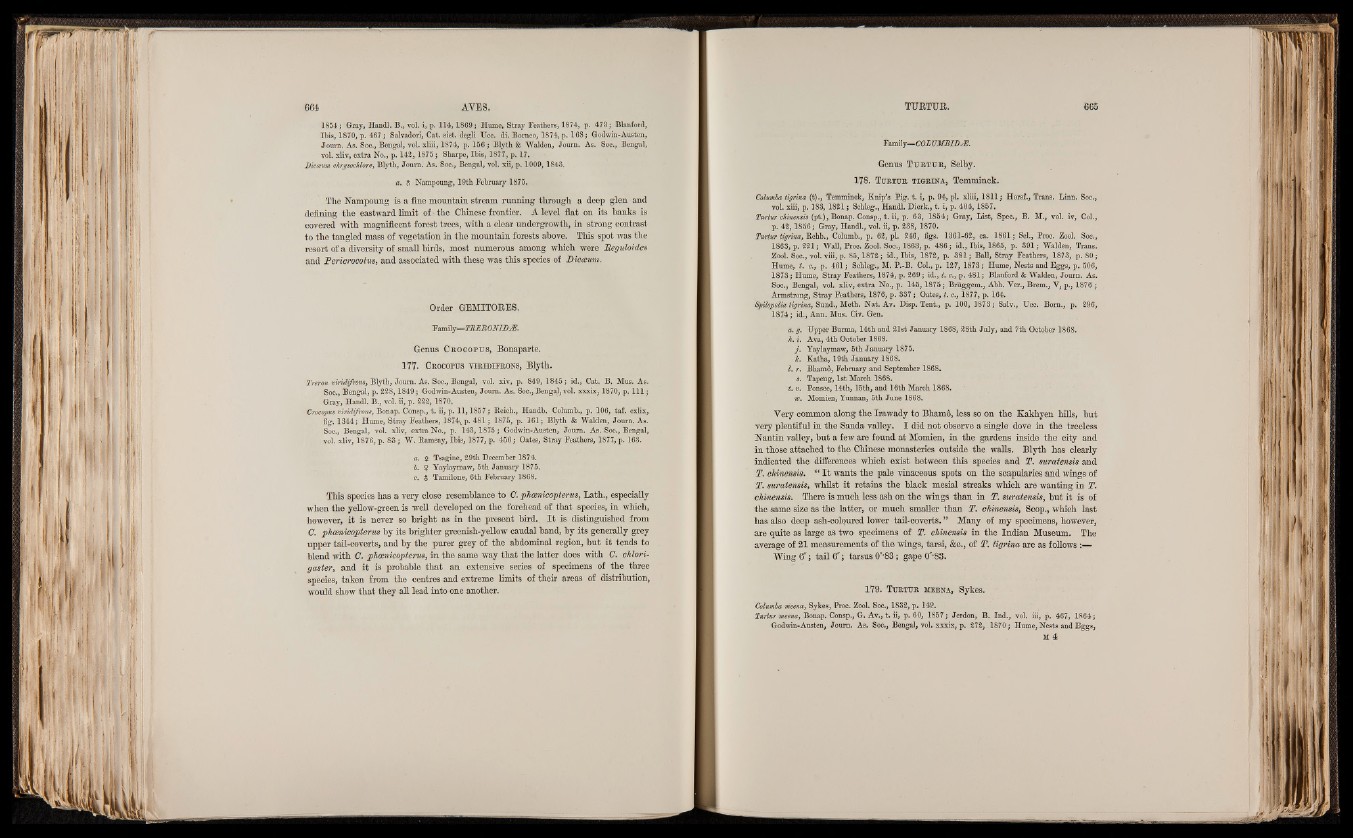
1854; Gray, Handl. B., vol. i, p. 114,1869; Hume, Stray Feathers, 1874, p. 478; Blanford,
Ibis, 1870, p. 467; Salvadori, Cat. sist. degli Ucc. di. Borneo, 1874, p. 168; Godwin-Austen,
Journ. As. Soc., Bengal, vol. xliii, 1874, p. 156; Blyth & Walden, Joum, As. Soc., Bengal,
vol. xliv, extra No., p. 142, 1875; Sharpe, Ibis, 1877, p. 17,
Dicaum chrysochlore, Blyth, Journ. As. Soc., Bengal, vol. xii, p. 1009, 1848.
a. $ Nampoung, 19th February 1875,
The Nampoung is a fine mountain stream running through a deep glen and
defining the eastward limit of - the Chinese frontier. A level flat on its banks is
covered with magnificent forest trees, with a clear undergrowth, in strong contrast
to the tangled mass of vegetation in the mountain forests above. This spot was the
resort of a diversity of small birds, most numerous among which were JReguloides
and Pericrocotus, and associated with these was this species of Diccewn.
Order GEMITOKES.
Family—TBfflt ONID2E.
Genus C r o c o p u s , Bonaparte.
177. C rocoptjs v ir id i p r o n s , Blyth.
Treron viridtfrons, Blyth, Journ. As. Soc., Bengal, vol. xiv, p. 849, 1845; id., Cat. B. Mus. As.
Soc., Bengal, p. 228, 1849; Godwin-Austen, Joum. As. Soc., Bengal, vol. xxxix, 1870, p. I ll ;
Gray, Handl. B., vol. ii, p. 222, 1870, .
Croc opus viridifrons, Bonap. Consp., t. ii, p. 11,1857; Reich., Handb.- Columb., p. 106, taf. cxlix,
fig. 1844; Hume, Stray Feathers, 1874v p. 481; 1875, p. 161; Blyth & Walden, Journ. As.
Soc., Bengal, vol. xliv, extra No., p. 148, 1875; Godwin-Austen, Joum. As. Soc., Bengal,
vol. xliv, 1876, p. 83; W. Ramsay, Ibis, 1877, p. 456; Oates, Stray Feathers, 1877, p. 168.
a. ? Tsagine, 29th December 1874.
b. $ Yaylaymaw, 5th January 1875.
c. $ Tamilone, 6th February 1868.
This species has a very close resemblance to C. phcenicopterus, Lath., especially
when the yellow-green is well developed on the forehead of that species, in which,
however, it is never so bright as in the present bird., I t is distinguished from
C. phcenicopterus by its brighter greenish-yellow caudal band, by its generally grey
upper tail-coverts, and by the purer grey of the abdominal region, but it tends to
blend with C. phcenicopterus, in the same way that the latter does with C. chlori-
gaster, and it is probable that an extensive series of specimens of the three
species, taken from the centres and extreme limits of their areas of distribution,
would show that they all lead into one another.
Family— COLUMBIDM
Genus T u r t t t r , Selby.
178. T u r t u r t ig r in a , Temminok.
Columba tigrvm (t)., Temminck, K nip’s Pig. t. i, p. 94, pi. xliii, 1811; Horsf., Trans. Linn. Soc.,
vol. xiii, p. 183, 1821; Schleg., Handl. Dierk., t. i, p. 404, 1857.
Tv/rim chinensis (pt.), Bonap. Consp., t. ii, p. 63, 1854; Gray, List, Spec., B. M., vol. iv, Col.,
p. 42,1856; Gray, Handl., Vol. ii, p. 288, 1870.
Tv/rtwr tigrvm, Rchb., Columb., p. 62, pi. 246, figs. 1861-62, ca. 1861; Scl., Proc. Zool. Soc.,
1863, p. 221; Wall, Proc. Zool. Soc., 1868, p. 486; id., Ibis, 1865, p. 891; Walden, Trans.
Zool. Soc., vol. viii, p. 85, 1872; id., Ibis, 1872, p. 881; Ball, Stray Feathers, 1873, p. 80;
Hume, t. c., p. 461; Schleg., M. P.-B. Col., p. 127, 1873; Hume, Nests and Eggs, p. 506,
1873; Hume, Stray Feathers, 1874, p. 269; id., t. c., p. 481; Blanford & Walden, Journ. As.
Soc., Bengal, vol. xliv, extra No., p. 145, 1875; Bruggem., Abh. Ver., Brem., Y, p., 1876 ;
Armstrong, Stray Feathers, 1876, p. 337; Oates, t. c., 1877, p. 164.
Sflilopelia tigrma, Sund., Meth. Nat. Av. Disp. Tent., p. 100, 1878; Salv., Ucc. Born., p. 296,
1874; id., Ann. Mus. Civ. Gen.
a. g. Upper Burma, 14th and 21st January 1868, 28th July, and 7th October 1868.
h. i. Ava, 4th October 1868.
j. Yaylaymaw, 5th January 1875.
Jc. Katha, 19th January 1868.
I. r. Bhamo, February and September 1868.
s. TapeHg, 1st March 1868.
' t. v. Ponsee, 14th, 15th, and 16th March 1868.
w. Momien, Yunnan, 5th June 1868.
Very common along the Irawady to Bhamd, less so on the Kakhyen hills, but
very plentiful in the Sanda valley. I did not observe a single dove in the treeless
Nantin valley, but a few are found at Momien, in the gardens inside the city and
in those attached to the Chinese monasteries outside the walls. Blyth has clearly
indicated the differences which exist between this species and T. suratensis and
T. chinensis. “ I t wants the pale vinaceous spots on the scapularies and wings of
T. suratensis, whilst it retains the black mesial streaks which are wanting in T.
chinensis. There is much less ash on the wings than in T. suratensis, but it, is of
the same size as the latter, or much smaller than T. chinensis, Scop., which last
has also deep ash-coloured lower tail-coverts. ” Many of my specimens, however,
are quite as large as two specimens of T. chinensis in the Indian Museum. The
average of 21 measurements of the wings, tarsi, &c., of T. tigrina are as follows :—
Wing 6"; tail 6"; tarsus 0"‘83; gape 0"*83.
179. T u r t u r m e e n a , Sykes.
Columba meena, Sykes, Proc. Zool. Soc., 1832, p. 149.
Turtur meena, Bonap. Consp., G. Av., t. ii, p. 60, 1857; Jerdon, B. Ind., vol. iii, p. 467, 1864;
Godwin-Austen, Journ. As. Soc., Bengal, vol. xxxix, p. 272, 1870; Hume, Nests and Eggs,
M 4